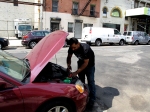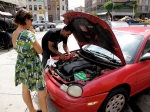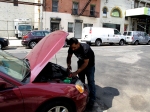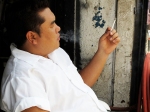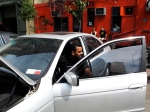This article was written as an enterprise piece for my Reporting and Writing class in Fall 2011. It documents the struggle of HIV infected women in Coney Island, and the organization that strives to help them.
They’re still here: Poverty and disease in “America’s Playground”
By Anne Cohen
Ibian DeSoto was diagnosed with HIV/AIDS in 1991. At the time, she said, she was completely uninformed about the effects of the disease. “The doctor came in and said ‘You have AIDS’ and walked out,” she said.
Almost 20 years later, on the second floor of the Iglesia Pentacostal de Jesu Cristo, in Coney Island, roughly 40 people gathered to celebrate World AIDS Day with sandwiches, soda, and games. The Amethyst Women’s Project, a community non-profit organization that does crisis-intervention counseling and HIV testing, hosted the event. After mingling and greeting old friends, people sat down at the four tables covered in green plastic tableclothes. DeSoto, now a volunteer at Amethyst, got up to speak. “My name is Ibian DeSoto and I am living with HIV, not dying,” she said.
After her diagnosis, no counseling was offered. Depressed and confused, DeSoto was sent back home to care for her 9-year-old daughter. “I was afraid she was going to get sick from me,” she said. “I was telling people I had cancer, not AIDS. I was embarrassed.”
It got so bad that DeSoto started smoking crack. One day in 2002, as she was walking down Mermaid Avenue to score, Aida Leon, founder of the Amethyst Women’s Project, pulled up in her car. They spoke, and after some hesitation, DeSoto followed Leon to the Amethyst building, where she got referred to a rehab facility and got counseling.
DeSoto has now been a volunteer at the Amethyst Women’s Project for seven years. Her T-cell count is up, and the virus is undetectable in her system. “She’s my savior,” she said, referring to Leon.
In the last couple of years, Coney Island has undergone tremendous changes. Famous for its boardwalk and amusement parks that once attracted visitors from all over the world, the neighborhood fell into disrepair in the 1970s.
According to Cristobal Jacques of the New York City HIV Prevention Bureau, Coney Island is a hidden hotspot of HIV. This has to do with how the data is collected: the numbers are diluted by the surrounding data from other neighborhoods, meaning that the good data dilutes the more troubling numbers. “The rest of the city doesn’t even come close,” he says.
The Amethyst Women’s Project has recorded a 3.9% seropositivity – indicating the presence of antibodies to HIV- rate over the last six years of testing, a number that is extremely high for a population of only 100 093 (as of 2010).
“Coney Island has a serious epidemic in ratio, not raw numbers,” he said.
The New York City Department of Health and Mental Hygiene estimated as of 2002 that 1.3-1.8% of the overall population of New York City was living with HIV/AIDS.
Over the last six years, the Amethyst Women’s project has tested 3,900 people for HIV and identified 150 new cases. All services are free; Amethyst only has two full time staff members, the rest are volunteers. They pay their expenses with grants by the New York State Department of Health AIDS Institute, the New York City Department of Health and Mental Hygiene and the Daphne Foundation. In 2010, they had a budget of 302 000 dollars, 200 000 of which was devoted to peer outreach.
Though it is the only non-profit in the area offering counseling and HIV testing for free, its finances are dwindling. This means reprioritizing and finding creative ways to make things work.
The Amethyst Women’s Project received funding from the Center for Disease Control from 2004 to 2010. After the 2010 deadline, it reapplied for funding, but was denied, despite CDC recognition of its good work. As a result, professional, full-time staff were cut and Amethyst has had to rely on its volunteers.
To continue to provide HIV testing despite budget cuts, Amethyst partnered with Harlem United and the Foundation for Research on Sexually Transmitted Diseases, which sends one tester to the Amethyst building on Mermaid Avenue every Thursday. They also provide two additional people to work with the Amethyst Peers and go out into the community to raise awareness.
***
Leon decided to found Amethyst for personal reasons. “Every time I came down here it was to bury somebody who’d been killed by the virus.” This is her community; she grew up in Coney Island in the 1960s and 70s. “The more I came, the sadder I felt. There were no flowers, there were no people. They were scared that if they came, they might catch this disease.”
“When I came, she was in a box. A box!” As she told the story of her friend, who died from HIV after slowly wasting away, at the World AIDS Day lunch, Leon stopped, and gulped back a sob, unable to go on. Murmurs from the attendees of “It’s alright baby,” and “We love you Aida,” encouraged her to continue. “If it wasn’t that she had bones, she would have ceased to exist,” she finished.
After her best friend’s death, Leon decided something had to be done. She founded the Amethyst Women’s Project in 1999, and worked out of her brother’s garage until she could afford to rent a building in 2001.
Robyn Mandelbaum is a volunteer who has been with Amethyst since 1999. She remembers all too vividly what the neighborhood looked like then: there were prostitutes everwhere, dealers on every corner, and addicts nodding out in alleyways. She gestures towards the open window: “In ’99 you wouldn’t have been able to walk out here. In fact I had a hard time coming out here. The streets were different, they were raw,” she said. “So we came in here.”
“Here” is the small white building on Mermaid Avenue. As you walk in, you find yourself in the waiting room, a small square room with four black chairs. A bowl full of free condoms sits atop the reception desk.
There are six “peers” total; they raise awareness, give out condoms and pass out literature. Before starting, the peers undergo a 10-week training session to learn everything from public speaking to creating a PowerPoint presentation. Most are living with HIV or recovering from addiction; they know these issues from firsthand experience.
Over the last 10 years, Leon estimated that Amethyst has served over 20 000 people in the community. According to Melisa Garber, peer coordinator at Amethyst, roughly 8 to 10 people come get tested for HIV every week. Those who need it are referred out to detoxification and rehabilitation programs, medical clinics, halfway houses and shelters. Though the organization is geared towards treating women, they also offer testing to men.
According to Dominguez, women often bear the brunt of heterosexual HIV infection. This is consistent with the semi-annual surveillance report put out by the New York City Department of Health and Mental Hygiene. As of June 2010, only 7.3 percent of male cases were from heterosexual activity, compared to 48.1 percent of female cases. Furthermore, 22.1 percent of males living with HIV/AIDS resided in Brooklyn, as opposed to 30.3 percent of women.
Dominguez blames to two things: lack of information, and machismo. “Most of the women are not engaged in high risk heterosexual activity, or injection drug use. They are not sleeping around, they’re infected by their own partners,” he explained.
That was the case of Tracey Mackie. After living with her boyfriend for eight years, Mackie, 49, found out he had been HIV positive the whole time, and had not told her. She found out three years ago, after her boyfriend started getting so sick she had to bring him to the hospital. His family had known the whole time, and never told her.
“I felt hurt,” she said. “I felt like he didn’t trust me. I felt like he made up my mind on his own.” She has not seen him in three years, but still gets tested every six months. Though she keeps testing negative for HIV/AIDS, she is still afraid that it’s a matter of time before she turns up positive.
***
On the street in front of the Iglesia Pentacostal de Jesu Cristo, Emma Roberts, Harm Reduction Coordinator for the Foundation for Research on Sexually Transmitted Diseases, was signing up people for STD testing, while the After Hours Project, another partner of Amethyst’s, did HIV testing in the back of a van. 20 people got tested for HIV, 7 were screened for sexually transmitted infections, and 4 were screened for Hepatitis C.
Roberts believes that there are not nearly enough services in Coney Island for a population that it is need. According to her, the services provided by the local hospital and medical clinics have a bad reputation, or are not close enough for regular access.
“If you compare Coney Island to other parts of Brooklyn, they have nothing [social services] on their doorstep. They have to travel for most services. That involves a Metro-Card! And if you’re homeless…” Roberts said with indignation.
Coney Island is part of a larger phenomenon taking place all over Brooklyn, the borough with the highest rate of concurrent diagnosis – people finding out they have AIDS at the same time as they find out they are HIV positive. “People are getting into treatment late,” Jacques said. “One third of people tested don’t make it to treatment.”
This was the case for DeSoto. She found out she had AIDS at the same time she found out she was HIV positive, after coming into the hospital with what she later found out were opportunistic infections – deadly infections that take advantage of immuno-compromised patients.
But it is not only a proximity problem. The very message of awareness needs to evolve as target and risk populations change.
The strategies for HIV/AIDS awareness have changed since Leon founded Amethyst in 1999. Giving out condoms is no longer enough. According to Leon, AIDS awareness is a double-edged sword. Young people who have grown up knowing about the disease perceive it in a nonchalant way. The deadly epidemic no longer frightens them- it’s a foreign disease, relegated to the depths of Africa. “Today we have to really try to ensure that these kids understand that this is not an STD – it’s deadly,” she said. The Amethyst peers regularly give talks dealing with HIV/AIDS and domestic violence in local high schools and after school programs.
On the other end of the spectrum, Amethyst also deals with newly arrived immigrants from Latin America who lack information about HIV/AIDS. “We try to bring basic awareness, you know, like ‘You can’t get HIV because somebody coughed on you,’” she explained.
***
Ten years after moving into the building on Mermaid Avenue in 2001, Leon dreams of expanding the counseling services that Amethyst offers to the entire family unit. “I come from a place that says you treat a woman, you treat the community,” she said.
But the services needed have changed.
What started out as a project to give out condoms to sex workers hanging out on street corners has expanded into plans to offer onsite medical services. According to her, mental health has become a glaring issue. “We want to make this a one stop shop,” she said.
There is of course opposition. Amethyst would like to partner with Mermaid Medical, a local clinic that has rented space in a building further down Mermaid Avenue. The new building is in a heavily residential area. As a result, residents are worried that Amethyst Women’s Project setting up shop there would bring in undesirable elements; elements which, according to Leon, are already in their backyard. Charles Reichenthal, district manager for Community Board 13 was unavailable for comment after multiple attempts to reach him.
According to Roberts, the investment going in on the area has had mixed effects. Though it has created pockets of affluence, like Sea Gate, a closed community at the edge of Coney Island, it has also created tension between newcomers and low-income residents. “Residents are becoming very vocal about what they don’t want to see in Coney Island,” she said. For some, that includes the Amethyst Women’s Project, and the people they serve.
After speeches, and a screening of a short film called “Still Around”, Leon got up to introduce a slideshow of those in the community lost to HIV/AIDS since 1999. The lights dimmed, and silence fell on the previously chatty audience.
One after the other, the pictures appeared: men and women, mostly in their 20s and 30s, some smiling, some not. As the slideshow went on, people whispered the names of their friends and family in the darkness as they appeared on the screen. Noises of recognition could be heard amidst the sniffles of stifled tears. One woman whispered, “I forgot about him…Wow,” and buried her face in her hands.
As the lights came back on, people wiped their faces and stood, the smiles returning to their faces. Mandelbaum and DeSoto hugged. They were still here.




